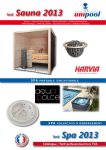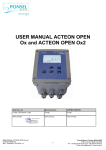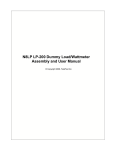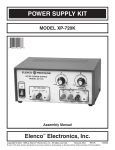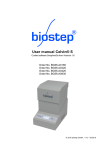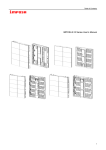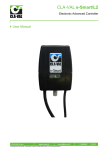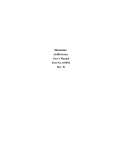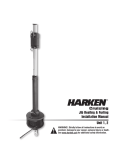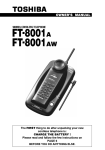Download Spectrafuge 16M service manual
Transcript
SERVICE MANUAL for LABNET SPECTRAFUGE 16M MICROCENTRIFUGE Contents Section 1 General Description of Operation ............................................................ 1 Specifications ........................................................................................... 2 Section 2 Warranty Information ............................................................................... 3 Section 3 Troubleshooting ....................................................................................... 4 Section 4 Service Instructions ................................................................................. 5 Maintenance ................................................................................. 5 Cleaning and lubrication Removing the rotor Maintaining the rotor Rotor screw Speed Calibration Service Procedures ...................................................................... 7 Removing housing and lid assembly Motor Replacing the motor Printed circuit board Verifying connections Replacing the PCB Miscellaneous components Timer and momentary switch Lid latch mechanism Braking transformer Section 5 Illustrations ............................................................................................ 11 Section 6 Spare Parts List ..................................................................................... 19 Section 7 Schematics and Drawings ..................................................................... 20 Section 1 General Description of Operation This centrifuge is generally used in biological and biochemical research laboratories where small samples must be subjected to high RCF (g-force) for relatively short time intervals (usually thirty minutes or less). Designed to accept popular micro-test tubes with captive caps in a high speed rotor, this centrifuge will provide centrifugal forces as high as 16,000 times the power of the earth's gravity (16,000 x g)* The major functional components of the centrifuge are as follows: Motor Brushless DC motor. Printed Circuit Board The "brain" of the centrifuge, the microprocessor based circuit board controls the lid lock, operation, speed and acceleration/deceleration rates of the unit. Speed Control Located on the left side of the front panel. Turn to set the desired speed. Speed is set directly with this knob, i.e. a setting of 4 corresponds to 4,000rpm, a setting of 10 corresponds to 10,000rpm, etc. Timer This knob is located on the right side of the front panel. It acts as both an on/off switch and a timer. The desired time is set by turning the knob. Time is set in 1 minute increments, to a maximum of 30 minutes. Turning the knob to the zero position starts the deceleration of the rotor to a stop. The timer can be bypassed by pressing the quick button. A hold position can be actuated by rotating the timer knob counterclockwise. The knob may be turned in either direction before or during a run without damaging the mechanism. Lid Latch This electronic mechanism prevents operation of the centrifuge when the lid is open. Driven by a solenoid and controlled by the circuit board, this latch keeps the lid locked until the rotor has almost come to a complete stop. An emergency lid latch release, located in the left side of the unit below the quick button, allows access to the rotor in case of a power failure or component malfunction. Lid Switch Located to the right of the front panel. Pressing this button opens the lid of the centrifuge. This switch is disabled while the centrifuge is in operation. Lid Lock Indicator Located above the speed control. Indicates that the unit is in operation. When lit, the lid switch is disabled. Quick Button For short or quick spins. The centrifuge will operate at the preset speed while this button is pressed and stop when it is released. *Rotational speeds of this magnitude can be converted to "rim speeds" of nearly 300 miles per hour. Use extreme caution when working with this equipment. The technician should inspect the rotor periodically for visible signs of damage or stress. The rotor screw should be checked for tightness. 1 Section 1 Specifications Maximum speed ............................................................................................... 14,000 rpm ±5% . Maximum RCF .......................................................................................................... 16,000 x g Maximum capacity ....................................................................................... 36 mL (18 x 2.0 mL) Dimensions Width .............................................................................................. 209.5mm/8.25 in. Depth ................................................................................................... 226mm/8.9 in. Height .................................................................................................. 193mm/7.6 in. Weight ................................................................................................. 5.1kg/11.2 lbs. Noise level (with full rotor) .................................................................................... Approx. 56 dB Electrical Ratings 120V Version ......................................................................... 120V~, 50-60 Hz, 1.0A Fuse 250V,2.5AT 230V Version ......................................................................... 230V~, 50-60 Hz, 0.5A Fuse 250V, 1.25AT Ambient operating range ............................................................................... +2.0ºC to +40.0ºC 2 Section 2 Warranty Information Limited Warranty This warranty is valid in U.S.A. only Repair or Replacement The manufacturer warrants this equipment to be free of defects in material and workmanship for a period of 12 months from the original date of purchase. This warranty includes labor and parts, and excludes damage caused by abuse or neglect. If defects occur during the warranty period, the manufacturer will, at its option, repair or replace the product. Proof of purchase is required. In-Warranty Service We will provide warranty service if you bring to our attention, within 12 months from date of original purchase, a defect covered by the warranty. To obtain warranty service, you must do the following: 1) Call the Customer Service number, printed below, to arrange for warranty service. The Customer Service Representative will give you a Return Authorization Number (RAN): Customer Service 732 417-0700 Hours of operation: 8:30 am to 5:00pm, Eastern Standard Time Monday through Friday (excluding holidays) 2) Shipping instructions: Pack the unit in its original packaging or a protective carton, padded to avoid damage. UPS is the preferred shipper. Labnet will not be responsible for damage resulting from improper packaging. Send package postage prepaid Include the following: and insured to: a) All accessories originally included, unless otherwise instructed National Labnet Company b) A copy of your proof of purchase 162 Fernwood Ave c) Your name and shipping address Edison, NJ 08837 d) Name and phone number of contact person (no collect shipments accepted) e) A brief written description of the problem Exclusions and Limitations This warranty does not cover the following: a) Damage caused by transit or improper packaging b) Damage caused by accident, misuse, negligence, improper installation or maintenance, improper operation, damage resulting from dirt, water, lightening or other natural forces. c) Damage caused by tampering, alteration or repair performed or attempted by anyone other than the manufacturer or its authorized repair agent d) Damage to the finish or paint Legal Rights and Limitation of Liability ALL WARRANTIES, INCLUDING THE IMPLIED WARRANTY OF MERCHANTABILITY AND THE IMPLIED WARRANTY OF FITNESS FOR A PARTICULAR PURPOSE ARE LIMITED IN DURATION TO 12 MONTHS FROM THE DATE OF ORIGINAL PURCHASE. REPAIR OR REPLACEMENT IS PROVIDED AS THE SOLE AND EXCLUSIVE REMEDY. NATIONAL LABNET COMPANY IS NOT LIABLE FOR INCIDENTAL OR CONSEQUENTIAL DAMAGE, COMMERCIAL LOSS, OR ANY OTHER LOSS OR DAMAGE NOT SPECIFIED IN THIS WARRANTY. Some states do not allow limitations on the length of implied warranties, or exclusions of limitation of incidental or consequential damages. The above limitations or exclusions may not apply to you. This warranty gives you specific rights. You may have other rights which vary from state to state. No individual has the authority to extend this warranty period. No individual can accept for or on behalf of the manufacturer, any other obligation of liability in connection with the sale of this equipment. This warranty is valid only in the United States of America and only for the original purchaser. For out of warranty service, call our Customer Service Department for information: 732 417-0700. 3 Section 3 Troubleshooting Problem Possible cause Solution Lid will not open (with power/rotation light on). Rotor still turning. Wait for rotor to stop. Internal electrical failure. Requires service. No power supply. Check plug connection on back of unit. No power supply. Check/replace fuse. No power supply. Check wall outlet. Internal failure. Requires service. Debris lodged inside rotor. Disassemble and clean out rotor. Rotor improperly loaded. Load symmetrically/balance tubes. Rotor damaged. Requires service or replacement. Centrifuge not on firm, level surface. Relocate to appropriate surface. Motor damaged. Requires service. Lid not properly closed. Press down firmly on front of lid. Timer not set. Select a timer interval. Speed not set. Select a speed from 1,000 to 14,000rpm. No power supply. Check plug connection on back of unit. No power supply. Check/replace fuse. No power supply. Check wall outlet. Rotor screw is not tight on motor shaft. Tighten rotor screw as firmly as possible by hand. Then tighten an additional 1/8 turn using a wrench or other appropriate tool. Do not exceed 1/8 turn. Bottom shield of rotor is not properly secured to top part of rotor. Check and tighten the three screws on bottom of rotor assembly. Whistling noise (high-pitched) during acceleration or deceleration. Rotor cover is off and rotor is less than 1/3 full. Add extra tubes symmetrically and/or install rotor cover. Power/rotation light does not illuminate. Defective fuse. Check/replace fuse. Excessively noisy while rotating at maximum speed. Rotor is poorly balanced. Check with a well balanced load. Rotation is too fast. Recalibrate speed. Failure of electronic braking circuit. Requires service. Lid will not open (with power/rotation light off). Excessive vibration. Rotor does not rotate. Grinding or metallic rattle noise during acceleration or braking. Rotation light stays on after rotor has stopped. 4 Section 4 Service Instructions MAINTENANCE Beginning after the first 300 hours of use, and periodically thereafter, a qualified electronics technician should inspect the centrifuge. Cleaning & Lubrication CAUTION Removing the rotor The rotor, rotor chamber and centrifuge casing must be kept clean. Using a cloth damp with water or mild detergent, the casing and chamber should be wiped clean and kept in "likenew" condition. Clean all spills immediately, removing the rotor for best results. No routine lubrication is necessary. Disconnect from power source before any cleaning procedure. No flammables or solvents are to be used, especially in the presence of electrical power or in a recently used (still warm) centrifuge. 1) Using an adjustable or 1/4 inch wrench, loosen the rotor screw and remove the rotor retaining screw/washer assembly by turning it counter-clockwise. 2) Lift the rotor straight up and out of the chamber. 3) To reinstall the rotor, reverse the above procedure. Be sure the cross pin on shaft lines up with slot on underside of rotor. Maintaining the rotor CAUTION The rotor must be checked periodically (every 12 months or more often if required) for signs of wear, damage or misuse. Corrosive materials must be promptly cleaned and thoroughly removed. For best results, disassemble the rotor by removing the 3 screws at the bottom and pulling the upper and lower components apart. The rotor must be reassembled in the same orientation. The rotor can be autoclaved or wiped with radioactive decontaminant only when disassembled. It should not be soaked in decontaminant. When reassembling the rotor, be sure to return the upper and lower sections to their original orientation. Misalignment could result in a moderate imbalance and increased vibration during high and low speed operation. The three screws must be tightened firmly. Any cracks, deep scratches, stress marks or other damage to the rotor should be reported immediately. Any rotor exhibiting any of the above indicators must be removed from service immediately. Failure to do so may result in injury. 5 Section 4 Rotor screw The rotor screw must be kept tight enough that it cannot be removed by hand. If it has become loose, tighten it firmly, clockwise, by hand and subsequently torque an additional 1/8 turn using a wrench or other appropriate tool. Speed calibration After every 100 hours of use (or more frequently if required by other agencies) the maximum rotor speed should be verified using an external tachometer via the below procedure or another procedure as required by regulatory agencies. Speed calibration must be performed if the motor or circuit board has been replaced. Tools required: insulated screwdriver, non-conductive photo electric tachometer reflective adhesive contrast dot/tape 1) Remove metal chute (4 phillips screws) from bottom of unit. (See figure #3, pg 13.) This will expose a figure 8 shaped hole through which the speed adjust pots can be accessed. The rear-most is the high speed adjustment pot and the front-most is the low speed adjustment pot. 2) Elevate the unit in a normal upright operating position so that the adjusting pots can be accessed. Speed pot access 3) Install a small dot of reflective tape near the top outer edge of the rotor lid catch. Set the speed control on the front panel at maximum (#14), close the lid and turn on the unit using the timer. 4) Set up the tachometer through the clear window in the centrifuge lid to monitor rotor speed. Adjust the high speed pot (rear-most) so that the rotor speed measures approximately 14,000rpm on the tachometer. 5) Run the unit at this speed for a minimum of 5 minutes. 6) Adjust the high speed pot (rear-most) so that the rotor speed measures 14,000rpm, plus or minus 150rpm on the tachometer. 7) Rotate front panel speed control to #1 (1,000rpm) setting. Adjust low speed pot (front-most) so that the rotor speed measures approximately 1,000rpm. 8) Run the unit at this speed for a minimum of 5 minutes. 6 Section 4 9) Adjust the low speed pot (front-most) so that the rotor speed measures 1,000rpm, plus or minus 100rpm on the tachometer. 10) Replace the metal chute The unit is now calibrated. SERVICE PROCEDURES Take care when performing the following service procedures. Always disconnect the unit from power source before attempting any service operations. Removing Upper Casing Shell 1) Remove rotor as outlined in the rotor section. 2) Remove the 4 phillips head screws that secure the upper casing shell to the baseplate. (See figure #1, pg 12 for exact location of screws.) 3) Lift the upper casing shell upward until it is clear of the motor. Lay the upper casing on its side to the right of the baseplate. 5) For reinstallation, reverse the above procedures. CAUTION Always disconnect centrifuge from power source before attempting any service procedures. Failure to do so may result in electrical shock and serious injury to personnel. MOTOR The motor used in the manufacture of this centrifuge is a brushless, DC motor. This motor requires no routine maintenance and is virtually problem free. Most operational problems will be attributable to the circuit board rather than the motor. Replacing motor assembly If it has been determined that the motor should be replaced, the following instructions should be followed. Tools required: Phillips screwdriver Nut driver (11/32") or small adjustable wrench 1) Remove the upper casing shell as previously described. Remove the metal chute as described in the speed calibration section. 7 Section 4 2) Unplug the motor connection from the PCB. 3) Loosen the ground nut and remove the motor ground lead (figure #4, pg 14). 4) Remove the 4 motor nuts on the bottom of the baseplate (figure #5, pg 15). Remove motor assembly and 4 star washers under the isolators from unit, noting the orientation and routing of motor and ground leads. 5) Install new motor assembly (with star washers on isolator studs) in chassis in the same orientation as the old motor. Attach and tighten the 4 motor nuts on the bottom of the unit. Be sure the isolators are not twisted. 6) Plug the motor connector into the PCB and attach ground lead under ground nut and tighten securely. 7) Make sure air channels are installed down against foam. 8) Reinstall upper casing shell and tighten screws securely. 9) Calibrate speed as previously described on page 6. 10) After calibration, reinstall metal chute. Speed must be recalibrated after replacing the motor. Failure to do so may result in serious injury. CAUTION PRINTED CIRCUIT BOARD (PCB) The majority of failures that cannot be attributed to the motor can be traced to printed circuit board component failure. If the fault has been isolated to the PCB, it is recommended that a new board be installed. For those who prefer to troubleshoot to the component level, board diagrams are provided in Section 7. Verifying Connections All of the various centrifuge components are connected to the PCB. Depending upon the nature of the fault, the technician should verify that these connections are secure, while the unit is disconnected from the power source. Replacing the PCB Tools required: Phillips screwdriver 1) Remove the upper casing shell as previously described. 8 Section 4 2) From the bottom of the unit, remove the 2 PCB mounting screws and nuts that secure the PCB brackets to the baseplate (see figure #6, pg 16). 3) One at a time, remove each of the 3 plug in connectors from the old PCB and install into the same location on the new PCB. 4) Position the new PCB so that the 2 mounting bracket holes are aligned with the two baseplate holes and reinstall the 2 PCB mounting screws and nuts. 5) Replace the upper casing shell as previously described. Tighten the 4 screws securely. 6) After reassembling the unit and reinstalling the rotor, the speed must be calibrated according to the instructions in the "Speed Calibration" section. CAUTION Speed must be recalibrated after replacing the PCB. Failure to do so may result in serious injury. MISCELLANEOUS COMPONENTS Timer & Momentary Switch If the unit will not rotate when the timer is turned on, press the momentary switch. If the unit still does not rotate, the problem is not attributable to the timer or momentary switch. However, due to the fact that both switches are used for identical internal switching, a quick diagnosis is easy to perform. Any time that one of these two controls is operational and the other is not, the latter control is either the victim of a short circuit connection, or is defective and should be replaced. Lid Latch Mechanism The lid latch is disengaged by a DC solenoid and is essential to proper operation. For safety reasons, no attempt should be made to modify, tamper with or defeat the latch mechanism. To actuate the lid latch release, depress the "lid" button on the front panel. The release can only be actuated when the lid is completely closed and latched and the rotor is not turning. The technician should be aware of the interaction between these components at all times during the troubleshooting process. In the event that the lid latch mechanism will not energize, power to the solenoid should be verified. To access the entire latch assembly, remove the upper casing shell as previously described. 9 Section 4 After removing, turn the upper casing so that the inside of the front panel is visible (figure #7, pg 17). If power to the solenoid is present, but the solenoid does not move, it should be checked and/or replaced. Other potential latch faults could be the result of poor wiring connections, poor alignment of the lid latch catch, sticking or jamming of the lid latch strike or no contact at the microswitch. If necessary the lid may be opened manually: 1. Disconnect the power cord from the wall socket power supply. 2. Remove the plastic plug, located on the left side of the unit, below the quick button. 3. Pull the cord (attached to the plug) to open the lid lock manually. Stepdown Transformer CAUTION The stepdown transformer supplies 24 VAC to the PCB. If power is not present, check the primary and secondary windings for opens or shorts. To replace the transformer, follow these instructions. Always disconnect centrifuge from power source before attempting any service procedures. Failure to do so may result in electrical shock and serious injury to personnel. Tools needed: Phillips head screwdriver 1) Remove the outer casing as previously described. 2) Remove the two mounting screws and nuts holding the transformer in place (see figure #8, pg 18). 3) Remove the wire connectors one at a time from the old transformer and transfer to the same positions on the new transformer. 4) Line the new transformer up over the mounting holes and secure the two mounting screws and nuts. 5) Replace the outer casing. 10 Section 5 Illustrations Figure 1 Spectrafuge 16M Tach window Lid Upper casing Lid switch Timer Quick button Speed control Lid lock indicator 11 Figure 2 Position of screws holding upper casing to baseplate (shown from bottom of unit) Casing-baseplate screw Casing-baseplate screw Casing-baseplate screw Casing-baseplate screw 12 Figure 3 Position of metal chute and attachment screws (view from bottom of unit) Metal chute with screws at the 4 corners 13 Figure 4 Location of motor and motor ground nut Motor Motor ground nut 14 Figure 5 Location of nuts holding motor in place (bottom view of unit) Motor nuts 15 Figure 6 Location of PCB and its mounts PCB PCB mounts 16 Figure 7 View of front control panel electronics Underside of front control panel 17 Figure 8 Location of transformer and transformer mounts Transformer mounts Transformer 18 Section 6 Spare Parts Catalog # Description Price C0160-CB Circuit board $270.00 C0160-E Motor, complete C-0160-F Feet, set of 4 C0160-FUSE Fuse, 2.5amp (120V version) 1.75 C0160-FUSE1 Fuse, 1.25amp (230V version) 1.75 C0160-I Isolator 3.00 C0160-LB Centrifuge lid, Blue 80.00 C0160-LG Centrifuge lid, Grey 80.00 C0160-LL Lid latch 48.00 C0160-LP Centrifuge lid, Purple 80.00 C-0160-LR Centrifuge lid, Red 80.00 C0160-LT Centrifuge lid, Teal 80.00 C0160-MS Momentary switch C0160-RC1 Rotor cover and clasp C0160-SK Speed knob 6.00 C0160-TF Transformer 50.00 C0160-TK Timer knob 6.00 C0230-T30 Timer, 30 minute C02300-P2 Motor crosspin 3.00 C1236-M Rotor screw 3.00 295.00 12.00 Please specify serial number when ordering parts. Prices effective May 1999. Subject to change without notice. 19 6.00 30.00 73.00 Section 7 Schematics and drawings This page intentionally left blank 20 Wiring Diagram - 120V Wiring Diagram - 230V Control Board Reference Reference C1, C9, C19, C20 C2, C4, C6, C7, C8, C10, C18 C3, C14, C16, C17 C5 C11 C12 C13 C15 C21 CAP1, CAP2 CLIM1 CR1, CR2, CR3 CR4 CR5, CR6, CR7, CR8, CR9, CR10, CR11, CR12, CR13 D1 F1 IEC INPUT CONN1 L1 LED1 LID SAFTY SW1 LID SW1 MOTOR1, PANEL1, POWER1 PULSE1 Q1 Q2, Q3, Q4, Q5, Q6, Q10 Q7 Q8, Q9 R1, R19, R29 R2 R3, R4, R9, R11 R5 R6 R7, R26, R28 R8 R10 R12 R13 R14, R24 R15 R16, R17 R18 R20, R30 R21 R22 R23 R25 R27 R31 R32 R33 RP1 RP2 RP3 RP4 Part NIC NRSA 100 M 35V 5X11 TR NIC NCMA10 Z5U 103 M 100 TR NIC NCMA30 Z5U 105 M 50 TR NIC NCMA20 Z5U 104 M 50 TR NIC NRSA 222 50V 18X36 TR NIC NRSA 101 50V 8X11.5 TR NIC NRSA 330 35V 5X11 TR CAP NOT NEEDED NIC NRM 105 K 100 EXT MELEXIS US5881UA NONLATCHED HALL SENSOR P6KE15CA 1N5240B DIODE UF4002 GBPC2501W REAR PANEL FUSE 2 AMP REAR PANEL LINE CONN. 5 TURNS ON TORROID FRONT PANEL LED LID SAFTY SW. FRONT PANEL LID OPEN SW. MOLEX 26-48-1086 FRONT PANEL PULSE SW. 2N7000 IRFZ46n TECOR S2015L IRFZ34N 4.7K 1/4W 5% 470 OHM 1/4W 5% 10K 1/4W 5% 390 OHM 1/4W 5% 47K 1/4W 5% 100K 1/4W 5% 1MEG 1/4W 5% 2.2 MEG 1/4W 5% 39K 1/4W 5% NOT USED 1.5K 1/4W 5% 1K 1/4W 5% 3006P-102 BOURNS 180K 1/4W 5% 3.3K 1/4W 5% 2K 1/4W 5% 200 OHM 1/4W 5% 820 OHM 1/4W 5% 1 OHM 10W 5% 68K 1/4W 5% 82 OHM 1/4W 5% 82 OHM 1/4W 5% 130 OHM 1W BUSSBOURNS 4605-101-102 BOURNS 4604-101-103 BOURNS 4606-102-681 BOURNS 4604-101-272 Control Board Reference - continued Reference SAFTY1 SOLENOID1 SPEED1 T1 TIMER1 U1 U2 U3 U4 U5 U6 U7 U8 U9 WH1, WH2, WH3, WH4 Part HEADER 4 PIN NOT USED LID OPEN SOLENOID 24 VAC FRONT PANEL POT 100K TRANSFORMER FRONT PANEL TIMER SW. ATF16V8BQL-25PC LM7815T LM339CN LM7805T ULN2003N LM555CN MOC3010 MAX954EPA CD4093BCN PAD






























